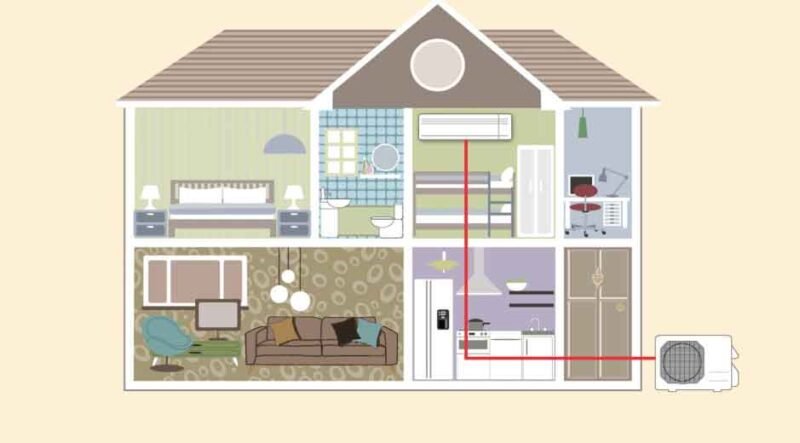Selecting the right ductless air conditioning system for your home or business requires understanding how each option works and how it aligns with your specific needs. Single-zone and multi-zone systems offer distinct approaches to cooling, energy management, and installation requirements. Your choice impacts comfort, efficiency, and overall cost. We will explore the distinctions between these systems and factors that can guide your decision, from room size and layout to energy consumption and future flexibility. A well-informed choice ensures consistent temperature control, improved air quality, and a cooling system that complements your lifestyle or business environment.
Factors to Consider When Choosing Between Single‑Zone and Multi‑Zone Systems
- Cooling Coverage and Room Requirements
Single‑zone ductless AC systems are designed to cool or heat one specific area, making them suitable for rooms that require individualized temperature control. If your space is small, such as a bedroom, office, or compact living area, a single‑zone system provides focused comfort without unnecessary energy expenditure. Multi‑zone systems, on the other hand, can service multiple rooms or zones simultaneously from one outdoor unit, offering the flexibility to maintain different temperatures in separate areas. This setup is beneficial for larger homes, open‑plan living spaces, or businesses with multiple offices. When planning for ductless AC installation in Kennett Square, considering the number of rooms and the cooling load for each space helps determine which system aligns with your requirements, preventing overbuying or underperforming installations.
- Energy Efficiency and Operating Costs
Energy efficiency can vary significantly between single-zone and multi-zone systems, depending on how the space is utilized. Single‑zone systems typically consume less power for individual rooms since they only operate when needed. This makes them cost-effective for spaces that aren’t used constantly. Multi‑zone systems, while offering convenience for whole-home comfort, may have higher initial costs and can consume more energy if multiple zones are used simultaneously. However, they allow for precise control of each zone, which can prevent energy waste from cooling or heating unused rooms. Evaluating your daily usage patterns, occupancy, and the potential for energy savings is essential in deciding which system provides long-term value.
- Installation Complexity and Space Considerations
Installing a single‑zone system is generally straightforward, requiring only one indoor unit and one outdoor compressor. This simplicity reduces installation time, labor costs, and potential disruption to your living or work area. Multi‑zone systems, however, involve connecting multiple indoor units to a single outdoor unit, which can require more planning, space, and coordination during installation. The placement of indoor units, the routing of refrigerant lines, and electrical connections must be carefully planned to ensure optimal performance. Understanding your property’s layout, structural limitations, and aesthetic preferences can influence whether a single-zone or multi-zone system is more practical and efficient to install.
- Temperature Control and Comfort Flexibility
Single‑zone systems offer consistent temperature control for one area but cannot adapt to varying needs in other rooms. This can be ideal if only certain rooms require air conditioning while the rest of the space is less frequently used. Multi-zone systems enable independent temperature settings for each connected zone, enhancing comfort for households or workplaces with varying preferences. Families, roommates, or office environments often benefit from this flexibility, as each area can be maintained according to individual comfort levels. Assessing how many people will occupy the space and their comfort expectations helps determine which system will deliver the most effective temperature management.
- Budget and Long-Term Considerations
Budget plays a crucial role in determining whether to choose a single-zone or multi-zone system. Single-zone setups are typically less expensive upfront, making them accessible for smaller spaces or those with limited budgets. Multi‑zone systems require a higher initial investment due to additional indoor units and more complex installation, but they can reduce the need for multiple outdoor units and offer scalability for future needs. Considering both the upfront cost and long-term operational expenses is important. Factoring in potential energy savings, maintenance, and possible expansion of cooled or heated spaces helps in evaluating which system represents a sustainable investment over time.
- Maintenance and Service Requirements
Both single‑zone and multi‑zone systems require regular maintenance to operate efficiently, including cleaning filters, checking refrigerant levels, and inspecting electrical components. Single-zone systems have fewer components, which can simplify service and reduce the potential for issues. Multi-zone systems, with multiple indoor units, may require more extensive maintenance and monitoring; however, they allow for servicing individual zones without affecting the entire system. Understanding the maintenance demands and your willingness to manage them contributes to making a practical decision. Ensuring access to reliable HVAC services can also influence which system is preferable for your property.
- Future Expansion and Flexibility
Another factor to consider is whether your cooling needs may change over time. Single-zone systems are limited to the space they serve and may require additional units if expansion is needed, which can increase costs and complicate installation. Multi-zone systems often allow for adding indoor units to new zones without requiring the installation of additional outdoor units, providing a flexible solution for growing homes or businesses. Planning for future changes in room usage, property modifications, or seasonal adjustments ensures your choice remains effective and adaptable. This foresight can prevent unnecessary replacements or retrofits in the future.
Selecting between single‑zone and multi‑zone ductless air conditioning systems involves examining cooling needs, energy consumption, installation logistics, comfort requirements, and budget considerations. Single-zone systems are ideal for focused cooling in individual spaces, offering simplicity and energy savings. Multi-zone systems, on the other hand, provide comprehensive comfort control across multiple rooms with the flexibility to adjust temperatures independently. By evaluating your current and anticipated needs, assessing property layout, and considering long-term costs, you can make an informed decision that enhances comfort, efficiency, and convenience in your home or workplace. Making the right choice ensures a system that performs reliably while adapting to changing requirements, maintaining a comfortable environment for everyone in the space.









